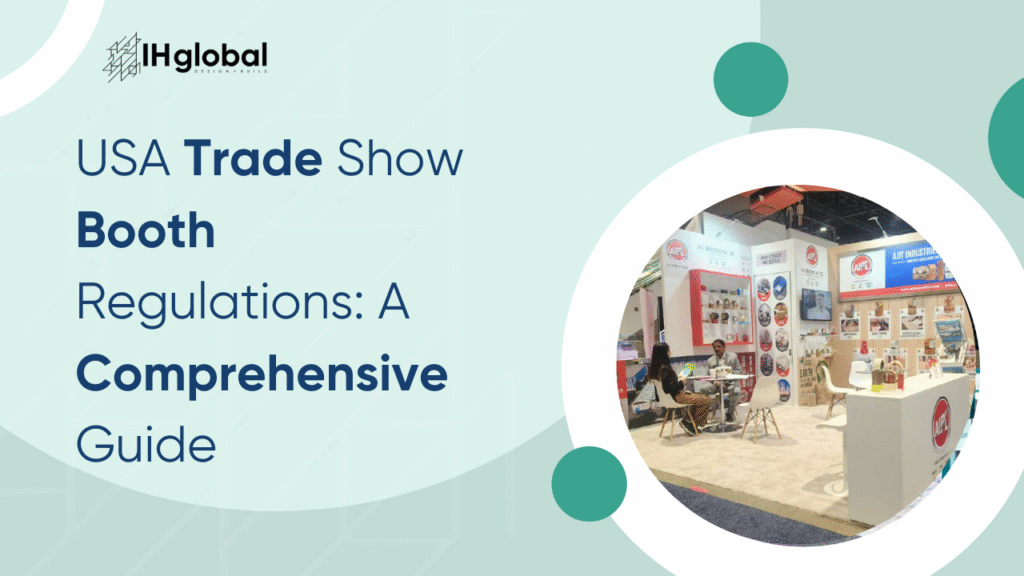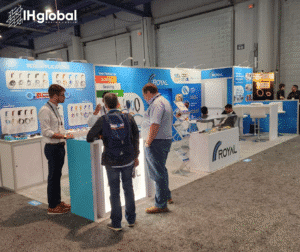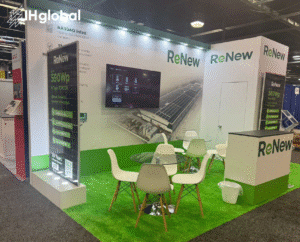Navigating trade shows in the United States can be a rewarding yet complex endeavor. In fact, over 13,000 trade shows are held annually in the U.S., making it a highly competitive and regulated space. Therefore, understanding standard USA booth regulations is crucial for exhibitors looking to make a lasting impact while ensuring compliance with event standards.
Each venue, organizer, and event type comes with its own nuances. Nevertheless, the common denominator across all exhibitions is adherence to foundational booth display regulations.
Accordingly, this guide dives deep into the essential USA trade show standards, providing a complete breakdown of booth types, height and signage rules, and the best practices every exhibitor should know, while emphasizing standard USA booth regulations at every turn.
Moreover, as international exhibitors or new participants might find the landscape confusing, this resource effectively decodes the intricate web of exhibition booth guidelines. As a result, it enables exhibitors to focus more on presentation and engagement rather than compliance hurdles.
Understanding Booth Types
Before diving into the finer details of standard USA booth regulations, it is important to first grasp the variety of trade show booth types. Additionally, each booth type not only has its own structure but also specific booth display regulations that dictate height, setback, and orientation.
Consequently, familiarizing yourself with these booth types can help you select the most effective format for your brand’s goals while ensuring adherence to standard USA booth regulations.
Linear Booths
To begin with, linear booths, also known as in-line booths, are the most common configuration at USA trade shows. Moreover, they are arranged in a straight line and typically share walls with neighboring exhibitors.
According to standard USA booth regulations, the depth is usually 10 feet, and the width may vary depending on the event’s layout. Consequently, one side opens to the aisle, which limits visibility to just three sides.
Furthermore, standard USA booth regulations dictate that the maximum height for linear booths is typically 8 feet. In addition, structures taller than this must be set back a specific distance from the aisle to maintain sightlines for neighboring booths.
Likewise, exhibitors must also comply with booth display regulations regarding backwalls, which should be finished and not contain logos that face adjacent exhibitors. Therefore, strict adherence to standard USA booth regulations is necessary to maintain uniformity and fairness across the trade show floor.
Perimeter Booths
Perimeter booths are essentially linear booths but are located along the outer walls of the exhibit hall. While they follow many of the same standard USA booth regulations as in-line booths, one major distinction lies in the height allowance.
According to standard USA booth regulations, perimeter booths often have a maximum allowable height of 12 feet. This flexibility allows for more dramatic displays, making perimeter booths ideal for brands looking to use vertical space more effectively.
However, exhibitors must still adhere to exhibition booth guidelines that require proper setbacks for structures above a certain height.
Peninsula Booths
A peninsula booth has aisles on three sides and shares a back wall with another exhibit. These booths typically occupy 20×20 feet or larger spaces and are considered premium spaces due to their high visibility.
Standard USA booth regulations for peninsula booths are more lenient in terms of structure height, allowing up to 16 or 20 feet, depending on the specific trade show. However, these booths must comply with setback requirements.
Any structure taller than 4 feet must be at least 5 feet away from adjacent booths, ensuring neighboring exhibitors aren’t blocked or overshadowed. Adhering to these booth display regulations helps maintain a balanced show environment.
Island Booths
Island booths are open on all four sides and typically begin at 20×20 feet. These booths offer the highest degree of flexibility and visibility. As such, they are often chosen by large companies wanting to create immersive experiences.
Exhibition booth guidelines for island booths allow a structure height of up to 20 feet or even more, depending on the venue and show-specific regulations.
Despite their flexibility, island booths must still follow standard USA booth regulations regarding safety, accessibility, and fire regulations. It’s also critical that no part of the structure blocks neighboring booths or aisle visibility.
Key Regulations to Consider
When participating in a USA trade show, understanding the core standard USA booth regulations is vital. These rules govern everything from structure dimensions to safety requirements and signage placement.
Height Restrictions
Different booth types come with varying height restrictions. Linear booths are generally capped at 8 feet, perimeter booths at 12 feet, and peninsula and island booths up to 20 feet. However, these figures can change depending on the specific show and venue.
According to standard USA booth regulations, exceeding height limits without prior approval can result in fines or dismantling requests. Therefore, it’s advisable to consult the trade show’s exhibitor manual for exact height allowances. Height restrictions ensure a level playing field and maintain visual harmony across the exhibition hall.
Setback Requirements
Setback rules play an essential role in standard USA booth regulations. These guidelines ensure that taller structures don’t impede line of sight or access to neighboring booths. For instance, if a peninsula booth features elements over 4 feet tall, those elements must be set back at least 5 feet from adjacent booths.
In many trade show booth types, especially peninsula and island configurations, adhering to setback requirements helps foster a visually open and inviting atmosphere. Violating setback regulations could lead to last-minute design changes or penalties, which is why it’s crucial to factor in these rules during the planning stage.
Signage Guidelines
Signage is one of the most critical components of any trade show exhibit. However, even this is governed by strict booth display regulations. Standard USA booth regulations specify where and how signage can be displayed to prevent obstructing other exhibitors or creating safety hazards.
For instance, hanging signs are typically only allowed in peninsula and island booths and must not exceed the height limit set by the trade show. Additionally, signs must face inward and not project into adjacent booth space.
It’s also important to comply with exhibition booth guidelines regarding lighting—spotlights must be aimed within the booth’s footprint.
Accessibility Standards
Trade shows in the USA are required to comply with the Americans with Disabilities Act (ADA). This means all booth designs must be accessible to individuals with disabilities. According to standard USA booth regulations, ramps, sufficient aisle width, and accessible displays are mandatory for public interaction areas.
Exhibitors must ensure that trade show booth types are designed inclusively. This not only meets legal obligations but also promotes brand inclusivity and engagement. standard USA booth regulations often include additional accessibility requirements, so it’s important to consult show-specific materials when designing your exhibit.
Best Practices for Booth Design
Adhering to standard USA booth regulations is only part of the equation. Effective booth design also requires creativity, strategy, and attention to user experience. Here are some best practices to help exhibitors maximize impact within regulatory constraints.
Firstly, understand the limitations of your chosen booth type. Whether you select a linear or island setup, design within the framework of relevant booth display regulations. This ensures a seamless approval process and avoids last-minute changes.
Secondly, focus on vertical space where permissible. Perimeter and island booths often allow taller structures, so consider incorporating large-format graphics or suspended signage. However, always ensure these elements meet standard USA booth regulations for height and structural stability.
Lighting can significantly enhance booth aesthetics. While following USA trade show standards on light direction and intensity, experiment with layered lighting to create focal points. Effective lighting not only highlights your product but also guides visitor movement through your booth.
Interactivity is another key consideration. Regardless of booth type, integrating digital screens, product demos, and VR experiences within your booth fosters deeper engagement. Still, ensure that these features are accessible, safe, and compliant with exhibition booth guidelines.
Lastly, plan for traffic flow. Especially in larger booth types like peninsula and island setups, it’s vital to facilitate smooth movement through the space. Proper layout and open sightlines help maintain compliance with setback rules while enhancing user experience.
Common Mistakes to Avoid
Even seasoned exhibitors sometimes falter when navigating standard USA booth regulations. Below are five common mistakes to watch out for:
- Ignoring height restrictions: Often, exhibitors assume they can extend vertical elements beyond the standard limits, especially in island or perimeter booth types. However, each show enforces specific height caps, and overlooking them can lead to costly violations under standard USA booth regulations.
- Improper signage placement: Additionally, many exhibitors fail to follow signage rules. For example, hanging signs that exceed height restrictions or extend beyond booth boundaries breach booth display regulations. Therefore, always consult the event manual to ensure alignment with standard USA booth regulations.
- Overcrowded layouts: Furthermore, densely packed booth setups hinder foot traffic and may obstruct access or visibility. Not only is this frustrating for visitors, but it may also violate USA trade show standards for accessibility and emergency routes. Thus, keeping your layout compliant with standard USA booth regulations is essential.
- Neglecting electrical compliance: In many cases, exhibitors forget that each venue has specific rules for wiring and equipment use. Consequently, failing to adhere to those electrical codes can lead to safety issues or power shutdowns, both of which breach standard USA booth regulations.
- Lack of preparation for inspections: Lastly, failing to prepare for pre-show inspections can disrupt your booth setup. Since event officials may verify every element for compliance, being unprepared could result in last-minute changes or penalties. Hence, thorough preparation ensures full adherence to standard USA booth regulations.
Avoiding these common mistakes not only safeguards your investment but also enhances your professional presence on the trade show floor.
Conclusion
Success at a USA trade show depends not just on what you present but how well you comply with standard USA booth regulations. From choosing the right booth type to understanding signage, setbacks, and accessibility requirements, there’s much to consider.
By aligning your booth design with trade show booth types and exhibition booth guidelines, you ensure a smooth, professional presentation.
Moreover, knowing the standard USA booth regulations in advance empowers you to create engaging, compliant exhibits that leave a lasting impression. For companies looking to make a mark, understanding and adhering to booth display regulations is not just recommended, it’s essential.
In summary, trade shows are a golden opportunity, but only for those who are prepared. Let this guide be your go-to resource as you plan your next exhibition in the United States.
Frequently Asked Questions (FAQs)
What are the basic height limits according to standard USA booth regulations?
Height limits vary based on booth type. Typically, linear booths are limited to 8 feet, perimeter booths up to 12 feet, and island or peninsula booths may go up to 20 feet, subject to venue approval under standard USA booth regulations.
Can I hang signage in a linear booth?
Generally, hanging signs are not allowed in linear booths under standard USA booth regulations. They are usually permitted only in island or peninsula booths, provided they meet the height and setback requirements.
Do I need to make my booth ADA-compliant?
Yes, according to standard USA booth regulations, all booths must comply with the Americans with Disabilities Act (ADA). This includes providing accessible ramps, clear pathways, and interactive features that everyone can access.
What happens if I violate standard USA booth regulations at a trade show?
Violations can result in penalties ranging from fines to forced booth alterations or even removal from the event. It’s always best to review the exhibition manual and comply with all standard USA booth regulations in advance.
Are setback requirements the same for all booth types?
Not exactly. While all booth types must observe some setback rules, standard USA booth regulations typically require peninsula and island booths to maintain a 5-foot setback for elements taller than 4 feet when adjacent to other booths.







